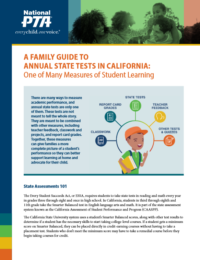Take Action Tag: Student Achievement
Student Assessments
State tests are an objective way of showing how well students met the expectations of the grade level. They are only one of many measures and aren’t meant to tell the whole story of a student’s performance. They should be combined with other information, such as report card grades, classwork and teacher observations to give families a more complete picture of their child’s academic performance.
In California, students in third through eighth and 11th grade take the Smarter Balanced test in English language arts and math. It is part of the state assessment system known as the California Assessment of Student Performance and Progress (CAASPP).
Depending on school calendars, testing in English Language Arts, mathematics, and science takes place mostly in April and May. Parents should receive their children’s reports soon after testing in their district is completed.
SMARTER BALANCED STATE ASSESSMENTS
The Smarter Balanced state assessment is focused on grade level material and is aligned to the state standards. The test questions match what students do and learn in the classroom everyday throughout the year, which are the skills that are most important for students to learn in order to move on to more challenging content.
The Smarter Balanced test is taken online and is computer adaptive, which means it adjusts the difficulty of the questions based on the student’s responses. The test includes a variety of different types of questions, including traditional multiple choice, ones that ask students to show their work and explain their answer, and questions that ask students to analyze text and write a well-developed essay. California teachers have worked closely with the state to write and review test questions.
PTA FAMILY GUIDE TO THE ANNUAL STATE TEST
National PTA developed the Family Guide to the Annual State Test which includes general information about the Smarter Balanced test, including grades and subjects tested, how the results are used and links to additional resources.
SCORE REPORTS: WHAT YOU NEED TO KNOW
The score report gives families information on how well their child performed on different sets of skills in each subject. Families can use this information to identify where their child is doing well and where they may need support or practice. This helps families better support learning at home. It can also help them to start meaningful conversations with teachers, to set goals for each student’s areas of improvement and to identify resources and strategies that can be used at home and in school to help students make progress.
- The CAASPP assessment report uses four achievement levels: standard not met, standard nearly met, standard met, standard exceeded. The levels designate the degree of “progress toward mastery of the knowledge and skills needed for success in future coursework.” For 11th-graders, they measure the degree to which students are on track to be ready for college or a career after graduating from high school.
- The scores help improve learning for your child. Scores give teachers the opportunity to adjust instruction and give students and parents an idea of which areas should get extra attention each school year and which areas students have mastered.
- Like progress on a growth chart, the tests, scores and expectations change with your child’s age and grade. As children grow and change, so do the educational standards and related assessments. Although you can see growth from year to year, scores can’t be directly compared to prior years, which measured different grade standards.
- The scores are just one measure of how your child is doing. These new tests are part of an overall system of assessment including classroom assignments, quizzes, report cards and more.
- Ask questions! The score reports generally go to parents before a new school year starts. Parents can start discussions on the score reports with their child’s teacher during back-to-school season and during parent-teacher conferences and other meetings.
ADDITIONAL RESOURCES
